| 2. Second Half of the Trip |
|
|
3rd day, October 28 (Sun)
Kurobe Gorge
This trip is for celebrating my wife Emiko's Kiju jubilee and just relaxing
in the hot springs. Besides, however, we would also like to enjoy the sightseeing
in Kurobe Gorge for a whole day. I had no other plan in my head.
This sightseeing should have carried out on the 2nd day at first, but the
weather forecast and the morning sky were not good. I was forced to put
off one day.
The sky is cloudy, but I don't think much rain today. At 9:00, took a shuttle
bus to Kurobe Unazuki Onsen Station. From here, I found my prospect was
largely wrong, and so we were confused..
Aside from waiting 30 minutes at the adjacent Shin-Kurobe Station, the
train was not yet a trolley train, and the destination was not Kurobe Gorge.
This was a station of the Toyama Regional Railway, and the train terminus
was Unazuki-Onsen Station. It took 30 minutes to get there. Then there,
we walked a little to Unazuki Station. This was the Kurobe Gorge Railway,
the first station of the trolley train.
The distance to the terminus Keyakidaira is 20.1 km. The trolley train
ran for an hour and a half, with several stops along the way.
It is sad because I had misunderstood the section of more than 2 hours
in total, including the transfer from Shin-Kurobe Station to the terminus
of the trolley train to Keyakidaira as only about 30 minutes. It was fatal.
In addition, according to a newly obtained pamphlet, there are four walking
areas in Kurobe Gorge, at the start and end points of the trolley train
and their sections. Unazuki, kuronagi, Kanetsuri and Keyakidaira. It was apparently only Keyakidaira in my mind. My speculation was also
that Kurobe Gorge and Kuroyon Dam are located in this area!
The last hotel shuttle bus to return is at 4:00 p.m. I should have given
up the bus and instead made use of a taxi. Nevertheless, as the bus ride
occupied my head, our sightseeing time around Kurobe Gorge was extremely
limited. According to a rough estimate, our allowed free time here around
Keyakidaira would be only one hour. Since it was the centerpiece of her
sightseeing this time, Emiko also expected a lot, but she reluctantly accepted
my awkward apology.
Therefore, our Kurobe Gorge sightseeing was only the trolley train to and
from Keyakidaira and a 10-minute course to the Riverbank Observatory right
there in Keyakidaira area. We could naturally not go to Meiken Onsen nor
Sarutobi Gorge Observatory, which the kind couple enthusiastically had
recommended the day before. We also had to give up Iwana cuisine.
However, enduring the cold, Emiko says, "The autumn leaves of the
gorge were second to none. I'm glad to come here."
Her words were a load off my shoulders.
|
A long time ago, I must have seen the movie "Kurobe no Taiyo."
It was released in 1968, directed by Kei Kumai and starred by Yujiro Ishihara
and Toshiro Mifune. Why do I only have the impression that the theme was
the struggle to build the Kurobe Dam?
In the wilderness of the V-shaped valley, the deepest in Japan, I could
see several hydroelectric power plants from the trolley train.
"The water of the Kurobe Dam is sent to the Kurobe River No. 4 Power
Plant built 10 km downstream through a special tunnel dug into the mountains
from the intake, and generates electricity at a drop of 545 meters from
the dam. It is also called "黒四ダム" (Kuro-Four Dam) from the name
of this power plant" (Wikipedia)

This trolley train.
Despite the caution of the couple yesterday, the windowed vehicles were
full on both ways and had to board the blue-ceiling vehicle. It was so
cold! Both of us put on a sweater, a raincoat, everything we had brought
with us, and managed to endure it.
Kurobe Gorge, other pictures
Just on time to the 4 o'clock shuttle bus. Thanks to that, before dinner, I was able to do bar hopping of the hotel's proud mural painting hot spring and the hot spring of Karna Hall.
Last day, October 29 (Mon)
Our reservation for the Shinkansen back to Tokyo departs from Kurobe Unazuki
Onsen Station at 18:45, and the last shuttle bus from Kintaro Onsen Hotel
to the station starts at 10:50 in the morning and takes only 10 minutes
until the train station.
How are we going to spend the eight hours after that? The time has come
without any specific idea.
There is nothing around the station area other than the adjacent gallery.
The sorry face of the hotel staff speaks for herself. She picked up a copy
and said at the end:
Why don't you go to Ikuji Town by a fixed-route bus?"
She says it is a port town facing Toyama Bay, where a restaurant with fresh
fish is recommended. Wandering around the harbour is also likely to kill
some time. It's about 30 minutes from the station.
We decided to follow her advice for the time being.
Ikuji, Kurobe City
Put our luggage in a locker at the Shinkansen station. While Emiko was
in a bathroom, a woman looking like a local lady passed by. I asked her.
"I'm sorry, I want to take the bus to Ikuji, ......"
"It's right there, and I'm going there too, so please follow me."
"I'm waiting for my wife, so would you tell me the direction?"
"You may get lost, so let's go together."
Saying so, she stayed naturally. Then Emiko came back.
It might be right there, but we turned left and right for about 5 minutes
to reach the station roundabout stop.
Seeming like nothing though, her compassion learned naturally was transmitted
to us. One instance shows all the rest. The warmth of the people in Toyama
Prefecture, at least in Kurobe and Uozu regions.
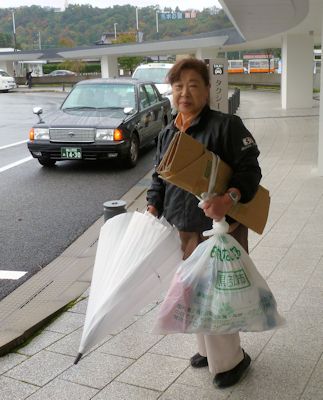
............
The route bus took about 30 minutes to the end point "Sea Station
Ikuji", and during the time I made an unexpected discovery. This area
is the base of YKK. Of the dozen bus stops, nearly half have the name of
YKK. Surprised. Looking through the window, everything is in good condition.
The YKK center park on the way, open to the public, is a large facility,
and it seems that you can experience not only exhibitions but also old
fastener making. Unfortunately, closed on Mondays. Couldn't kill time.
About the company, Wikipedia says:
"YKK is an abbreviation of the former company name Yoshida Kogyo Co.,
Ltd., and Y is the last name initial of the founder, Mr. Tadao Yoshida
(from Uozu City). The company is famous for the production of slide fasteners,
accounting for about 45% of the world share. It has a large-scale production
base in Kurobe City."
"Sea Station Ikuji" consisted of a "freshly taken"
souvenir shop and a "freshly made" restaurant.
After window shopping for a while at "freshly taken", lunch at "freshly made".
Emiko chose "Phantom FishTempura set meal", and me "Ikura Bowl".
My choice was just so so, while Emiko's was perfect. I got one fish meal,
certainly good. It was a small new discovery. Phantom Fish, lives in the deep sea of 300 m. The name itself was new to us.
This district is also called "Fresh Water Village", proud of drinking water. I surely drank two glasses of the delicious taste.
With 40 minutes to spare until the 13:40 bus to the station, we decided
to walk to the temple shown on the simple map.
We were able to pass the time effectively, including hanging out on the beach.
Regional Sightseeing Gallery
We still have 4 hours until the bullet train departure at 18:45. Entered
the "Kurobe City Regional Sightseeing Gallery" next to the station.
The exhibition hall is on the second floor.

The Kurobe Gorge and its surroundings, or rather, the mountainous area
of northeastern Toyama Prefecture, are introduced through photographic
exhibitions and a movie (10 minutes). We were looking around the exhibition
with somewhat unfocused eyes, and here again a lucky happening.
A senior gentleman, maybe a curator, spoke to us, and began to explain
in a polite and clear manner. It lasted nearly for one hour.
"From the 3,000m-class Northern Alps to the deep sea of Toyama Bay,
the dynamic wilderness with a height difference of 4,000m spreads out.
Water such as rain, snow, glaciers, clear streams, and spring water, circulates
around, and there are so abundant fishes like in a natural fish-pond. And
the unique water culture of the region making use of it is alive and well."
With such an introduction, his explanation continued while pointing to the diorama below and each exhibition, which impressed and frightened us so much.
It's nearly five o'clock. Thinking better to get going soon, I looked through
the window, and cried "Wow!"
The rainbow in the distance was seeing us off sorrowfully with Kurobe,
Unazuki, Uozu, and Kintaro Onsen for four days.
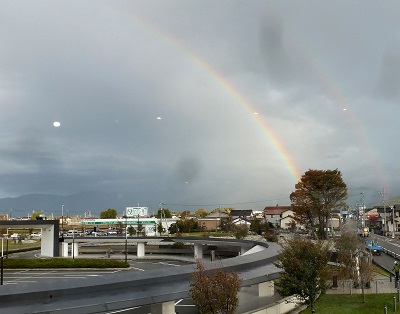
October 29, other pictures
………………………………
Hotel Kintaro Onsen
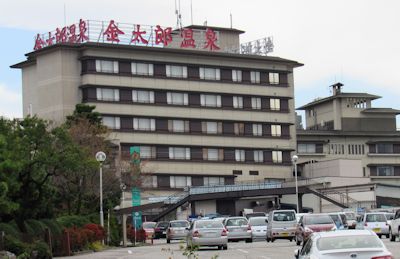
I had mistaken Hotel Kintaro Onsen for a hotel in Unazuki Onsen Township.
When I arrived, it was in the rural area on the outskirts of Uozu City,
far away from there.
For four days, this hotel has taken care of our couple, and we have gained
a good impression beyond expectation.
The building of Kintaro Onsen (金太郎温泉) is arranged as follows, and we stayed
in the Japanese-style room in the Kōfukaku Annex (光風閣別館) and soaked in
the hot springs morning and evening in either the mural painting public
bath hall (壁画大浴殿) or the Karuna Hall (カルナの舘).
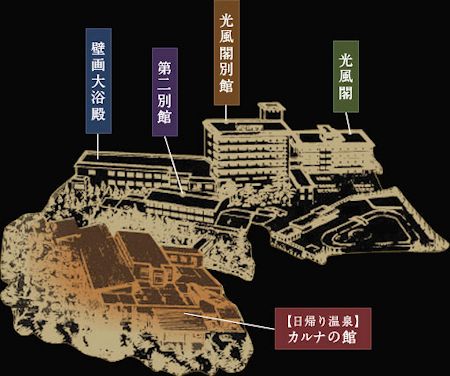
Transportation facilities are not bad. It takes 10 minutes by hotel shuttle
bus from either three stations, Kurobe Unazuki Onsen Station on the Hokuriku
Shinkansen, Shin-Kurobe Station on the Toyama Regional Railway connecting
to Unazuki Onsen Township, or Uozu Station on the Ainokaze Toyama Railway.
It has no connection to the fairy tale "Masakari no Kintaro",
but the founder Ishiguro Shichihei named it with the wish for it to be
healthy like Kintaro. Founded in 1965
Kintaro Onsen operates a one-house inn "Kintaro Onsen Kōfukaku"
and a day-trip bathing facility "Karuna Hall", and guests staying
at Kōfukaku can freely use the Karuna Hall. ("Karuna" is the
"goddess who protects health" in ancient Roman mythology.)
The quality of the hot springs is all a mixture of sulphur springs. The source temperature is 75°C.
For four days, from October 26 to 29, 2018, all we did were to soak in
the hot springs and to eat morning and evening dishes, but the hotel's
thoughtful warmth to the guests was quite natural. The front desk staff,
the cafeteria staff, the staff you meet in the hallway, every staff. The
way to answer questions isn't just about mouth and gestures. Ask them where
you want to go, and they'll take you there.
During meal time, both morning and evening, their responses are not customary,
and they are confirming our reaction with a smile. Our couple's table was
also away from the group guests, which gave us the feeling of a leisurely
trip just for the two of us.
The large lounge next to the front desk is good for relaxing. We relaxed, waiting for the bus.
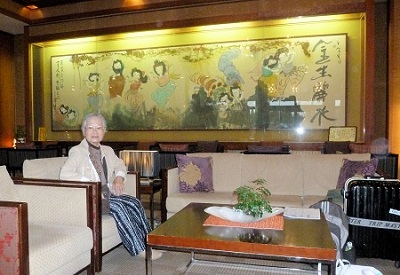 |
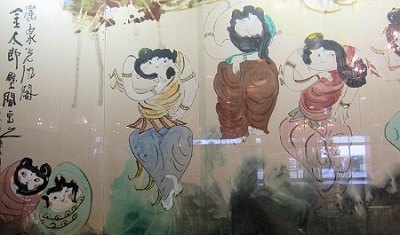 |
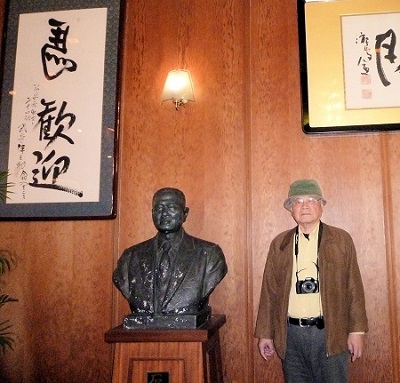 |
The peculiar letter "Left Horse" is said to be
a happy character that invites good fortune. |
This year, Kintaro Onsen was selected as one of the "100 Hotels and
Inns in Japan Chosen by Professionals" and for many years was one
of the "250 Most Popular Onsen Hotels Chosen by the Travel Industry".
Kintaro Onsen, other pictures
………………………………
The last day, Monday, October 29, just after 5 o'clock in the evening.
Leave the gallery and buy a sandwich for dinner at the station stall. During
the rest time, work this essay in the waiting room of the platform until
the departure time of "Hakutaka 574".
|